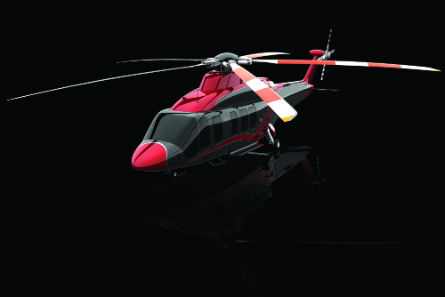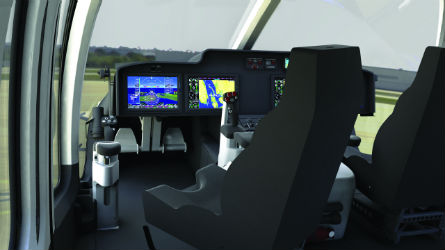Bell Helicopter will directly confront AgustaWestland and Eurocopter in the upper-medium helicopter class beyond 2014, following the 12 February unveiling of the new 525 Relentless, a "super medium" twin.
The 16-passenger type - which will be powered by two GE CT7-2F1 turboshaft engines down-rated to 1,800shp (1,320kW) each - will also incorporate a triple-redundant BAE Systems-built fly-by-wire (FBW) system, that interfaces with the pilots through a new Garmin G5000H integrated avionics suite developed for the project.
 |
|---|
© Bell |
The overall cockpit is being described as an "ARC" Horizon system, with ARC standing for awareness, reactive and control - a nod to advanced situational awareness, proactive hazard intervention and precise control.
 |
|---|
| © Bell |
Firsts for the 525R include being the industry's first commercial helicopter with forward-fit FBW, and Bell's first five-bladed, fully-articulated main rotor, according to Larry Roberts, Bell Helicopter's senior vice-president for commercial business.
Despite competition from AgustaWestland and Eurocopter with the AW189 and EC175, respectively - both of which are entering service years ahead in the offshore, search and rescue and VIP sectors - Bell is confident its advanced cockpit technologies and optimised per seat-mile costs will give it an edge.
Bell said the type's maximum payload will be 1,800kg (4,000lb) and its maximum range more than 740km (400nm). The company did not provide a radius of action with respect to the number of passengers, however.
"We looked at what's missing in the market," said Bell chief executive John Garrison at the Heli-Expo show in Dallas, Texas, on 12 February - where Bell unveiled a 525R mock-up for a waiting crowd.
"We believe we'll be able to bring a value proposition across the mission range in terms of seat-mile costs," he added.
Bell said input from a customer advisory panel was a key factor in major design decisions for the clean-sheet helicopter, including the choice of GE CT7 engines.
The engines will drive a five-bladed, fully-articulated main rotor system and four-blade tail rotor on the left side of a canted tail boom - itself designed with "lift assist" technology to boost effectiveness. "Bell has been looking at a fully-articulated rotor head design for some time," said Roberts. "What is news is that we're bringing it to market."
The 525R airframe will be a combination of metal and composite construction. Roberts said individual components may be made elsewhere, but that the production line would be at Bell's Amarillo, Texas plant. Roberts added that there are currently 330 engineers on the design team, but this figure will increase to more than 500 by the end of the year.
First flight is planned for 2014, with certification and entry into service as soon as possible, according to Garrison.
Development costs will be "consistent with other programmes" of this size, Roberts said - in the region of "several hundred million dollars". He added that Bell was not seeking any risk-sharing partners.
In recent years Bell sold its stake in both the AW139 and AW609 to AgustaWestland.
Source: Flight International



















